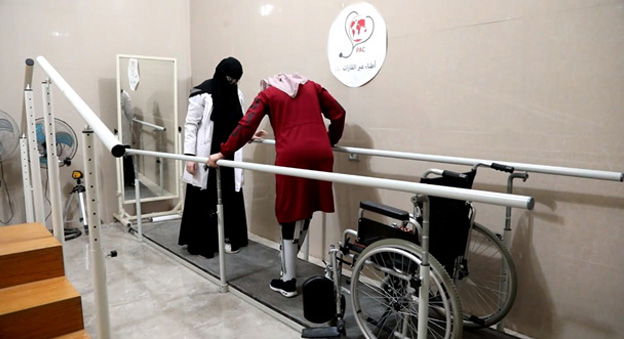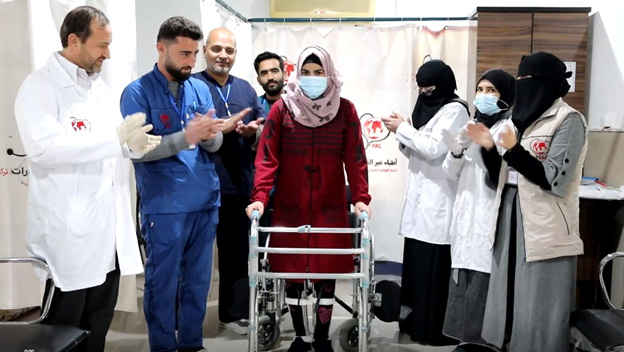 Yusra engages in physical therapy sessions at the rehabilitation centre to regain her mobility. Photo credit: Physicians Across Continents29 April 2024 – “I felt the ground shaking heavily, I ran to wake up my parents and my grandfather, then I went to wear clothes to run outside,” recounts Yusra*, a 23-year-old university student from Idlib governorate, north-west Syria. “That is all I can remember. My life had changed forever.”
Yusra engages in physical therapy sessions at the rehabilitation centre to regain her mobility. Photo credit: Physicians Across Continents29 April 2024 – “I felt the ground shaking heavily, I ran to wake up my parents and my grandfather, then I went to wear clothes to run outside,” recounts Yusra*, a 23-year-old university student from Idlib governorate, north-west Syria. “That is all I can remember. My life had changed forever.”
Yusra’s house collapsed on her as she was rushing to take cover during the series of deadly earthquakes that struck Syria and Türkiye in February 2023. Yusra was trapped beneath the rubble for many hours.
In Syria alone, the disaster caused nearly 5900 deaths and left more than 12 800 people injured. It uprooted hundreds of thousands of families, and severely damaged infrastructure already made weak by the conflict.
Most injuries sustained in the earthquake were those requiring specialized interventions and long-term rehabilitation. For example, spinal cord injuries, traumatic brain injuries, and orthopaedic conditions like fractures or crushed limbs, some of which called for amputations or other specialized orthopaedic care.
Yusra suffered from hemiplegia – a spinal cord injury that leads to paralysis on one side of the body – resulting in loss of movement in her right leg.
The psychological toll of the harrowing experience of both the earthquake and her physical injury was so profound that Yusra resisted treatment for many months.
Finally, her family convinced her to visit Step of Hope in Azaz, a subdistrict of Idlib. This WHO-supported rehabilitation centre is operated by Physicians Across Continents, a national nongovernmental organization, with generous funding from the Central Emergency Response Fund.
Individualized treatment and rehabilitation
 A triumphant moment for Yusra, and the entire medical team at the Step of Hope rehabilitation centre, as she takes her first steps following physical therapy. Photo credit: Physicians Across ContinentsReluctant to engage in treatment at first, Yusra gradually began to open up to the possibility of recovery thanks to the consistent support and encouragement of the Step of Hope staff.
A triumphant moment for Yusra, and the entire medical team at the Step of Hope rehabilitation centre, as she takes her first steps following physical therapy. Photo credit: Physicians Across ContinentsReluctant to engage in treatment at first, Yusra gradually began to open up to the possibility of recovery thanks to the consistent support and encouragement of the Step of Hope staff.
A tailored treatment plan for Yusra was drawn up to address both the physical and psychological aspects of her condition. Physical therapy sessions focused on improving mobility and functions. Occupational therapy aimed to restore independence in daily activities. She also received psychological support to overcome her trauma and rebuild her mental resilience.
The collaborative efforts of the centre’s health workers, including therapists, counsellors and support staff, played a pivotal role in her rehabilitation journey. Over time, Yusra made remarkable progress. She regained her mobility with the help of a walker, and her outlook became increasingly positive – so much so that she resumed her education.
“When I started the treatment, I was sceptical and afraid I would not be able to make any progress. I cannot describe my happiness being able to stand up and move my legs,” says Yusra. “Now I am determined to pursue my dreams, complete my education and become a teacher.”
In the aftermath of the earthquake, WHO supported 5 rehabilitation centres to provide similar inpatient rehabilitation services, reaching more than 23 000 people in north-west Syria.
*Name has been changed to protect privacy and security.








